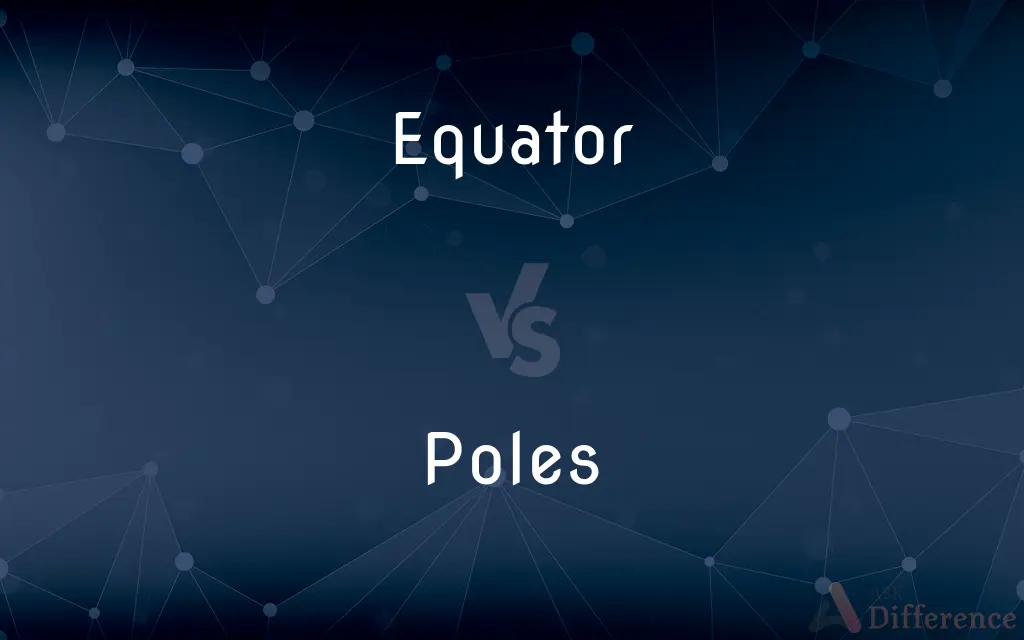Equator vs. Poles — What's the Difference?
By Urooj Arif & Fiza Rafique — Updated on April 17, 2024
The Equator is an imaginary line around Earth's widest part, marked by consistent warm temperatures; the Poles, located at Earth's extremities, experience extreme cold and prolonged periods of darkness or daylight.

Difference Between Equator and Poles
Table of Contents
ADVERTISEMENT
Key Differences
The Equator, an imaginary line encircling the globe at its widest point, represents a zone where the sun is directly overhead at least once a year, resulting in generally high temperatures year-round. In contrast, the Poles are characterized by extreme cold due to the sun's oblique angle, causing low solar irradiation.
Tropical regions around the Equator enjoy a relatively stable climate with little variation in daylight hours throughout the year. Conversely, the Poles experience dramatic variations, with polar night and midnight sun phenomena, where the sun does not rise or set for months.
The Equator bisects the Earth into the Northern and Southern Hemispheres and experiences rapid weather patterns due to the intense solar energy. On the other hand, the Poles, situated in the Arctic and Antarctic Circles, have slow and prolonged climatic changes influenced by their icy landscapes.
Biodiversity near the Equator is significantly higher, with dense rainforests and a wide variety of species, due to the warm and humid conditions. In contrast, the Poles support fewer life forms, primarily adapted to harsh, frigid environments.
Cultural and human activities near the Equator are influenced by agriculture and year-round crop growth, owing to the fertile soil and favorable climate. At the Poles, human presence is minimal, primarily focused on research and exploration due to the inhospitable conditions.
ADVERTISEMENT
Comparison Chart
Location
Along the latitude 0°
Earth's extreme north and south
Climate
Warm and stable temperatures
Extremely cold with severe temperature shifts
Daylight Variation
Minimal, with roughly equal day and night
Extreme, from 24 hours of daylight to darkness
Biodiversity
High, with dense rainforests and diverse species
Limited, mostly extremophiles and marine life
Human Activity
Dominated by agriculture and dense populations
Limited to research and some indigenous tribes
Compare with Definitions
Equator
The sun can be directly overhead at the Equator during equinoxes.
On the equinoxes, no shadow is cast at noon along the Equator.
Poles
The North and South Poles are points where the Earth's axis of rotation meets its surface.
The South Pole is located on the continent of Antarctica.
Equator
The Equator is a 0° latitude line that encircles the Earth equidistant from both poles.
Quito, Ecuador is one of the few cities through which the Equator directly passes.
Poles
Polar regions are crucial for climate research due to their sensitivity to global temperature changes.
Scientists monitor ice sheets at the Poles to study climate change.
Equator
The Equator is synonymous with tropical climates and biodiversity.
The Congo Rainforest near the Equator is one of the most biodiverse areas on Earth.
Poles
The Poles are characterized by ice-covered landscapes with minimal vegetation.
The Arctic is mostly ocean surrounded by land, whereas Antarctica is a landmass covered in ice.
Equator
It marks the division between the Northern and Southern Hemispheres.
GPS devices often indicate when you cross the Equator.
Poles
Indigenous cultures and modern explorations coexist at the Poles.
The Inuit people have adapted to life in the Arctic region over millennia.
Equator
Countries along the Equator experience relatively consistent weather patterns year-round.
Singapore, near the Equator, has a consistent climate with minor seasonal changes.
Poles
They experience the polar night and the midnight sun due to the tilt of the Earth's axis.
Barrow, Alaska has periods of 24-hour darkness in winter.
Equator
The Earth's equator is an imaginary planetary line that is about 40,075 km (24,901 mi) long in circumference. The equator divides the planet into the Northern Hemisphere and Southern Hemisphere and is located at 0 degrees latitude, the halfway line between the North Pole and South Pole.In spatial (3D) geometry, as applied in astronomy, the equator of a rotating spheroid (such as a planet) is the parallel (circle of latitude) at which latitude is defined to be 0°.
Poles
The Poles (Polish: Polacy, pronounced [pɔˈlat͡sɨ]; singular masculine: Polak, singular feminine: Polka), also referred to as the Polish people, are a West Slavic ethnic group and a nation that shares a common history, culture, the Polish language and is identified with the country of Poland in Central Europe. The population of self-declared Poles in Poland is estimated at 37,394,000 out of an overall population of 38,538,000 (based on the 2011 census), of whom 36,522,000 declared Polish alone.
Equator
The imaginary great circle around the earth's surface, equidistant from the poles and perpendicular to the earth's axis of rotation. It divides the earth into the Northern Hemisphere and the Southern Hemisphere.
Poles
Either extremity of an axis through a sphere.
Equator
A similar great circle drawn on the surface of a celestial body at right angles to the axis of rotation.
Poles
Either of the regions contiguous to the extremities of the earth's rotational axis, the North Pole or the South Pole.
Equator
The celestial equator.
Poles
(Physics) See magnetic pole.
Equator
A circle that divides a sphere or other surface into congruent parts.
Poles
(Electricity) Either of two oppositely charged terminals, as in an electric cell or battery.
Equator
An imaginary great circle around Earth, equidistant from the two poles, and dividing earth's surface into the northern and southern hemisphere.
Poles
(Astronomy) See celestial pole.
Equator
(astronomy) A similar great circle on any sphere, especially on a celestial body, or on other reasonably symmetrical three-dimensional body.
Poles
Either extremity of the main axis of a nucleus, cell, or organism.
Equator
The midline of any generally spherical object, such as a fruit or vegetable, that has identifiable poles.
Slice the onion through the equator.
Poles
Either end of the spindle formed in a cell during mitosis.
Equator
The celestial equator.
Poles
The point on a nerve cell where a process originates.
Equator
The imaginary great circle on the earth's surface, everywhere equally distant from the two poles, and dividing the earth's surface into two hemispheres.
Poles
Either of two antithetical ideas, propensities, forces, or positions.
Equator
The great circle of the celestial sphere, coincident with the plane of the earth's equator; - so called because when the sun is in it, the days and nights are of equal length; hence called also the equinoctial, and on maps, globes, etc., the equinoctial line.
Poles
A fixed point of reference.
Equator
An imaginary line around the Earth forming the great circle that is equidistant from the north and south poles;
The equator is the boundary between the northern and southern hemispheres
Poles
The origin in a polar coordinate system; the vertex of a polar angle.
Equator
A circle dividing a sphere or other surface into two usually equal and symmetrical parts
Poles
A point in the complex plane at which a given function is not defined.
Poles
A long, relatively slender, generally rounded piece of wood or other material.
Poles
The long tapering wooden shaft extending up from the front axle of a vehicle to the collars of the animals drawing it; a tongue.
Poles
See rod.
Poles
A unit of area equal to a square rod.
Poles
(Sports) The inside position on the starting line of a racetrack
Qualified in the time trials to start on the pole.
Poles
A native or inhabitant of Poland.
Poles
A person of Polish ancestry.
Poles
To propel with a pole
Boatmen poling barges up a placid river.
Poles
To propel (oneself) or make (one's way) by the use of ski poles
"We ski through the glades on corn snow, then pole our way over a long one-hour runout to a road" (Frederick Selby).
Poles
To support (plants) with a pole.
Poles
To strike, poke, or stir with a pole.
Poles
To propel a boat or raft with a pole.
Poles
To use ski poles to maintain or gain speed.
Poles
Plural of pole
The distance between the poles was three feet.
Common Curiosities
How long are days and nights at the Equator?
At the Equator, days and nights are almost equal throughout the year, each lasting about 12 hours.
What kind of human settlements are found at the Poles?
Human settlements at the Poles are mainly research stations and some indigenous communities, such as the Inuit in the Arctic.
Are there any countries located entirely at the Equator?
Yes, countries like Ecuador and Gabon are located entirely or predominantly along the Equator.
Can you see the Aurora Borealis from the Equator?
No, the Aurora Borealis, or Northern Lights, is typically visible in polar regions and not from the Equator due to its geographic proximity to the magnetic poles.
How does wildlife at the Equator compare to that at the Poles?
Wildlife at the Equator is diverse and abundant, including numerous species of birds, mammals, insects, and reptiles, while polar wildlife is adapted to harsh conditions and includes species like polar bears, penguins, and seals.
What challenges do researchers face when working at the Poles?
Researchers at the Poles face extreme cold, isolation, and logistical challenges in accessing and operating in such remote and harsh environments.
How does the Equator affect aviation and navigation?
The Equator affects aviation and navigation by serving as a reference point for geographical orientation and is used to calculate time zones and navigation routes.
What are the midnight sun and polar night phenomena?
The midnight sun refers to a phenomenon at the Poles where the sun remains visible at midnight during the summer, while the polar night occurs in winter when the sun does not rise for more than 24 hours.
What impact does the position of the Equator have on global weather patterns?
The Equator plays a critical role in global weather patterns, influencing ocean currents and wind patterns, which distribute heat and moisture around the planet.
Is there any vegetation at the Poles?
Vegetation at the Poles is sparse and primarily consists of mosses, lichens, and some grasses, adapted to extreme conditions.
How do seasonal changes at the Equator compare to those at the Poles?
Seasonal changes at the Equator are minimal, with little variation in temperature and daylight, unlike at the Poles, where seasonal changes are extreme.
How do temperatures vary at the Poles throughout the year?
Temperatures at the Poles can be extremely low in winter (often below -50°C) and relatively milder in summer, though still usually below freezing.
What are the ecological roles of the Equator and the Poles?
The Equator is crucial for biodiversity and carbon absorption due to its extensive rainforests, while the Poles regulate the Earth’s climate and act as early indicators of climate change effects.
What cultural practices are unique to regions near the Equator?
Cultural practices near the Equator often revolve around agriculture and festivals related to the solar cycle, taking advantage of the consistent climate.
What are some scientific studies conducted at the Poles?
Scientific studies at the Poles often focus on glaciology, climatology, and environmental science, including studying ice cores to track historical climate dat
Share Your Discovery

Previous Comparison
Remitter vs. Remittor
Next Comparison
Bay vs. GulfAuthor Spotlight
Written by
Urooj ArifUrooj is a skilled content writer at Ask Difference, known for her exceptional ability to simplify complex topics into engaging and informative content. With a passion for research and a flair for clear, concise writing, she consistently delivers articles that resonate with our diverse audience.
Co-written by
Fiza RafiqueFiza Rafique is a skilled content writer at AskDifference.com, where she meticulously refines and enhances written pieces. Drawing from her vast editorial expertise, Fiza ensures clarity, accuracy, and precision in every article. Passionate about language, she continually seeks to elevate the quality of content for readers worldwide.













































